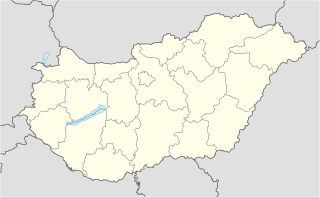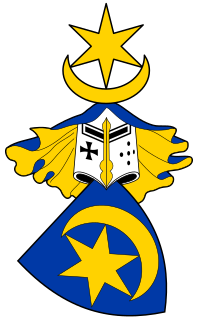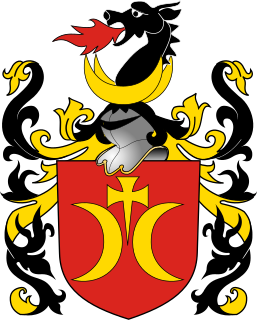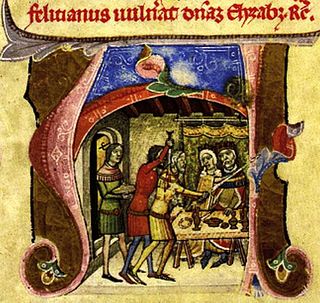
The Báthory family was a Hungarian noble family of the Gutkeled clan. The family rose to significant influence in Central Europe during the late Middle Ages, holding high military, administrative and ecclesiastical positions in the Kingdom of Hungary. In the early modern period, the family brought forth several Princes of Transylvania and one King of Poland and Grand Duke of Lithuania.

Máté Csák or Matthew III Csák, also Máté Csák of Trencsén was a Hungarian oligarch who ruled de facto independently the north-western counties of Medieval Hungary. He held the offices of master of the horse (főlovászmester) (1293–1296), palatine (nádor) and master of the treasury (tárnokmester) (1309–1311). He could maintain his rule over his territories even after his defeat at the Battle of Rozgony against King Charles I of Hungary. In the 19th century, he was often described as a symbol of the struggle for independence in both the Hungarian and Slovak literatures.

Borsod-Abaúj-Zemplén is an administrative county in north-eastern Hungary, on the border with Slovakia. It shares borders with the Hungarian counties Nógrád, Heves, Hajdú-Bihar and Szabolcs-Szatmár-Bereg. The capital of Borsod-Abaúj-Zemplén county is Miskolc. Of the seven statistical regions of Hungary it belongs to the region Northern Hungary.

Szikszó is a small town in Borsod-Abaúj-Zemplén county, Northern Hungary, 15 kilometres from county capital Miskolc.

Nyírbátor is a town in Szabolcs-Szatmár-Bereg county, in the Northern Great Plain region of eastern Hungary. With its historic atmosphere, this city is known for its 15th- and 16th-century ecclesiastic and secular architectural heritage and for the Báthory family, former landowners.

Somogydöröcske is a village in Somogy county, Hungary.

Aba is a noble kindred (genus) of the Kingdom of Hungary. Their ancestors may have been among the tribal leaders of the Kabars. The Gesta Hungarorum mentions that Ede and Edemen, the Abas' ancestors, received land possession around the Mátra Mountains, especially in Gyöngyöspata – Heves County, after the conquest of the Carpathian Basin by the Magyars. The Gesta Hunnorum et Hungarorum connects the family to Attila the Hun.
Csaba was Attila's legitimate son by the daughter of the Greek emperor Honorius. Csaba in turn had two sons, Edemen and Ed. Edemen entered Pannonia with his father's and mother's great entourage when the Hungarians came back for the second time, whereas Ed remained in Scythia with his father. Csaba is the ancestor of the clan of Aba.

Hont-Pázmány (Hunt-Poznan) was the name of a gens ("clan") in the Kingdom of Hungary. The Gesta Hungarorum mentions that the ancestors of the family, the brothers Hont (Hunt) and Pázmány (Pazman), originally from the Duchy of Swabia in the Holy Roman Empire, arrived in the late 10th century to the court of Grand Prince Géza of the Magyars:
The next arrivals were Hunt and Pazman, two half-brothers, courageous knights of Swabian origin. These two and their retainers had been journeying through Hungary with the intention of passing over the sea when they were detained by Duke Géza, and finally they girded King Stephen with the sword of knighthood at the river Hron, after the German custom.

Clan Ostoja was a powerful group of knights and lords in late-medieval Europe. The Clan encompass families in the Polish-Lithuanian Commonwealth, Upper Hungary (Slovakia), Hungary, Transylvania, Belarus, Ukraine, and Prussia. The Clan crest is the Ostoja coat of arms, and the battle cry is Ostoja ("Mainstay") or Hostoja. The Clan adopted the Royal-Sarmatian tamga draco (dragon) emblem.

Osl was the name of a gens with Pecheneg or Hungarian origin in the Kingdom of Hungary, based in today's Győr-Moson-Sopron County. The village of Osli was named after that clan.

Záh was the name of a gens in the Kingdom of Hungary. The clan was one of the 108 gentes during the Hungarian conquest of the Carpathian Basin and located in Nógrád County along with the Kacsics, Kartal, Kökényesradnót and Tomaj clans.
Türje was the name of a gens in the Kingdom of Hungary. The Szentgróti (Szentgiróti), Orbonay and Zalabéry families belong to this genus.

Matthew (II) from the kindred Csák was a powerful Hungarian baron, landowner and military leader, who held several secular positions during the reign of kings Béla IV, Stephen V and Ladislaus IV. He was the first notable member of the Trencsén branch of the gens ("clan") Csák. His nephew and heir was the oligarch Matthew III Csák, who, based on his uncles' acquisitions, became the de facto ruler of his domain independently of the king and usurped royal prerogatives on his territories.

The Kőszegi was a noble family in the Kingdom of Hungary and the Kingdom of Croatia in the 13–14th centuries. The ancestor of the family, Henry the Great descended from the gens ("clan") Héder. Henry's paternal great-grandfather was the clan's co-founder Wolfer.
Geregye was the name of a gens in the Kingdom of Hungary in the 13th century. The Egervári family originated from this clan. The ancient lands of the kindred were in Vas County.

Hahóti was the name of a short-lived lesser noble family in Zala County, Kingdom of Hungary in the 14th century.

Hermán was the name of a gens in the Kingdom of Hungary. The powerful Lackfi family ascended from this clan.
Péc or Pécz was the name of a gens in the Kingdom of Hungary. The powerful and illustrious Marcali and Apponyi noble families descended from this kindred. The clan had large-scale possessions in several counties of Transdanubia, in addition to Slavonia and other parts of the Kingdom of Hungary.

















